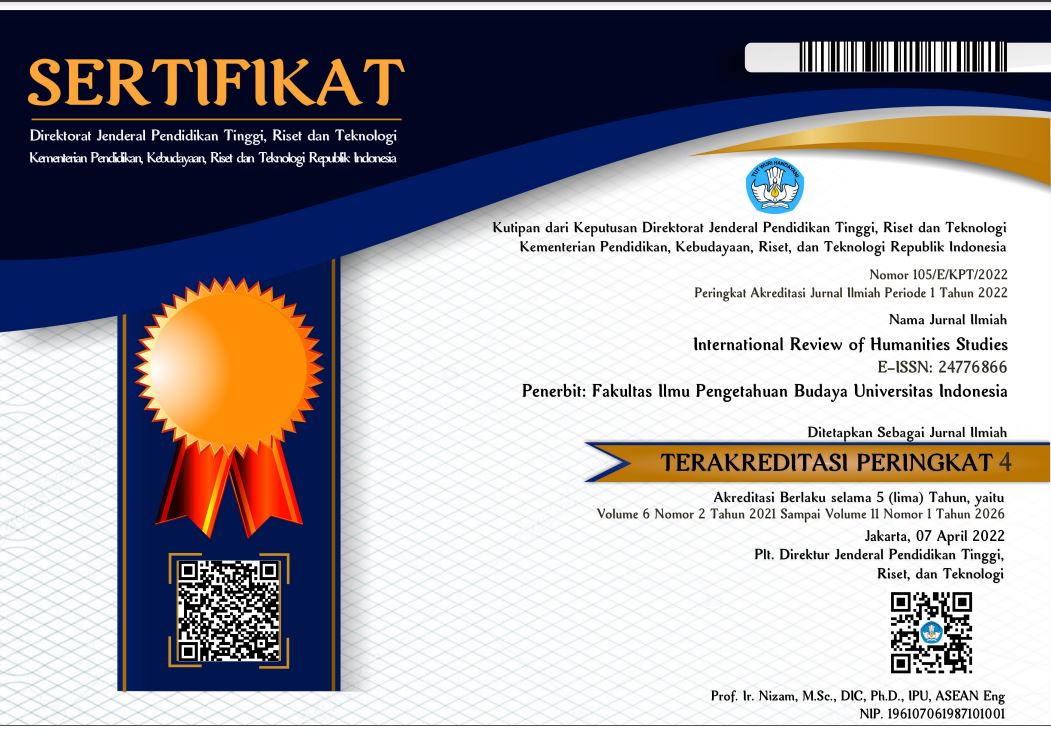International Review of Humanities Studies

Abstract
This article discusses communism in the film titled Čeburaška by Eduard Uspenskij. The study aims to identify the ideology of communism in Čeburaška. The Roland Barthes' semiotic theory was used to analyse the film. In order to see communism contained in Čeburaška, the author used two stages of Roland Barthes' semiotic theory of denotation and connotation. The research used descriptive and criticism methods. In analysing communism in Čeburaška, the author also use the following concepts: the concept of character and characterization, ideology, and film as an ideology. The research result shows that Čeburaška contains elements of communism that can be seen from the signs in every scene. These signs include the red color that denoted the symbol of communism, the nature of cooperation (communal) found in the characters, and the animals in the zoo that were described as free from the capitalist. The publication background of the film also influences the presence of communism in Čeburaška.
References
Allen, G. (2003). Roland Barthes. London: Routledge. Barthes, R. (1968). Elements of Semiology. New York: Hill and Wang.
Corbett, P. E. (1949). Postwar Soviet Ideology. American Academy of Political and Social Science, pp. 45—51.
Evans, Alfred B. (1993). Soviet Marxism-Leninism: The Decline of an Ideology. London: Greenwood Publishing Group.
Gillespie, David. (2003). Russian Cinema. London and New York: Pearson Education Limited.
Green, P. (1993). “Ideology and Ambiguity in Cinema”, The Massachusetts Review, Inc. Vol. 34, No. 1, pp. 102—126.
Joravsky, David. (1966). “Soviet Ideology”, Soviet Studies. Vol. 18, Issue 1, pp. 2—19.
Kroker, Arthur. (1991). “Ideology and Power”, Canada. Volume 15, Numbers 1—2 & 3. Kononenko, Natalie (2011). “Soviet and Post-Soviet Animation on Folklore Topics”, The Journal of American Folklore. Vol. 124, No 494, pp. 272—294.
Kaprisma, Hendra. (2015). “Ayat-Ayat Perjanjian Baru di dalam Arxipelag Gulag: Alih Wahana, Kode, dan Imajinasi Dialogis”, Disertasi. Depok: Program Studi S3 Ilmu Susastra Fakultas Ilmu Pengetahuan Budaya Universitas Indonesia.
Marko, Kurt. (1986). “Soviet Ideology and Sovietology”, Soviet Studies. Vol. 19, No. 4, pp. 465—481.
Nurgiyantoro, B. (2007). Teori Pengkajian Fiksi. Yogyakarta: Gajah Mada University Press.
Tertz, A. (1984). The Trial Begins and On Socialist Realism. Berkeley and Los Angeles: University of California Press.
Vázquez, A.S. (1973). Art and Society: Essay in Marxist Aeshetics. New York and London: Monthly Review Press.
Wesson, R. G. (1969). “Soviet Ideology: The Necessity of Marxism”, Soviet Studies. Vol. 21, No. 1, pp. 64—70.
Recommended Citation
Kaprisma, Hendra
(2019)
"COMMUNISM IN ЧЕБУРАШКА (ČEBURAŠKA) FILM: A SEMIOTIC STUDY,"
International Review of Humanities Studies: Vol. 4:
No.
2, Article 4.
Available at:
https://scholarhub.ui.ac.id/irhs/vol4/iss2/4
Included in
Arts and Humanities Commons, Business Commons, Education Commons, Law Commons, Social and Behavioral Sciences Commons


